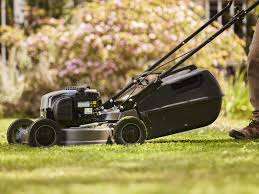If you’ve just purchased a brand new lawn mower or replaced the old blade on your existing mower, you might be wondering if you need to sharpen the new blade right away. After all, it’s fresh out of the package – how dull could it possibly be?
The answer may surprise you. While new lawn mower blades are indeed sharp when you first take them out of the box, they are not razor-sharp. Lawn mower blade manufacturers intentionally leave a slight dullness to the edge to prevent excessive wear and tear during shipping and initial use.
So in short, yes – new lawn mower blades do need to be sharpened before use for optimal cutting performance.
Also read: What to Do with a Large Backyard: 5 Ideas We Recommend
Table of Contents
Why Sharpen New Blades?

There are several important reasons why you should sharpen a new lawn mower blade before putting it to work on your lawn:
1. Cleaner Cuts
A razor-sharp blade will cut grass cleanly rather than tearing or shredding it. Clean cuts heal faster and are less susceptible to disease, fungus, and insect damage compared to frayed, torn grass blades. A sharp blade quite literally gives your lawn a “cleaner” look.
2. Healthier Lawn
Cleanly cut grass blades lose less moisture through the cut tips compared to shredded ones. This means your lawn retains more water and stays healthier during dry spells. Dull blades also put more stress on the grass plants, making them less vigorous over time.
3. Improved Mower Performance
Sharp blades require less power to cut through the grass, putting less strain on your lawn mower’s engine. This can extend the life of your mower’s engine and drivetrain components. Dull blades make the mower work harder and use more fuel.
4. Better Clipping Distribution
A sharp blade will cut grass into smaller, more uniform pieces that decompose faster when left on the lawn. This returns nutrients to the soil more efficiently. Dull blades shred grass into longer clumps that take longer to break down.
5. Fewer Passes Required
With a sharp blade, you can cut your lawn with fewer passes, saving you time and effort. Dull blades require more passes to cut the grass properly, which can also damage your lawn through excessive compaction.
How to Sharpen a New Lawn Mower Blade

Now that you understand the importance of sharpening new blades, here’s a quick guide on how to do it properly:
Materials Needed:
- Bench vise or blade balancer
- Flat mill bastard file or angle grinder with grinding wheel
- Gloves and eye protection
Steps:
- Remove the Blade: First, disconnect the spark plug wire and drain any remaining gas. Then, tip the mower on its side and remove the blade bolt to take off the blade.
- Secure the Blade: Clamp the blade firmly in a bench vise or blade balancer to hold it steady while sharpening.
- Inspect the Blade: Look for any major dents, chips, or cracks in the blade. If there is significant damage, replace rather than sharpen.
- Sharpen the Cutting Edge: Using a flat mill bastard file or angle grinder, carefully sharpen the cutting edge of the blade at the existing angle (usually 30-35 degrees). Apply even pressure in one direction only.
- Check Balance: After sharpening, check that the blade is still balanced by hanging it on a nail through the center hole. The heavy end should face down – grind off any heavier areas to rebalance.
- Reinstall the Blade: Once balanced, reinstall the sharpened blade, tightening the bolt to the manufacturer’s recommended torque setting.
How Long Does It Take To Sharpen A Lawn Mower Blade?

The time it takes to sharpen lawn mower blades can vary depending on the method used and the condition of the blades. Using a hand file might take about 10-15 minutes per edge if done carefully while using a bench grinder or angle grinder could reduce that time to 5 minutes or less per edge.
The entire process including removal, cleaning, sharpening, balancing, and reattaching the blade typically takes less than an hour
Tips for Maintaining Sharp Blades
To keep your lawn mower blade sharp and extend the time between sharpenings:
- Remove Debris: Clear the underside of the mower deck after each use to prevent stuck debris from dulling the blade over time.
- Avoid Obstacles: Steer clear of rocks, stumps, sprinkler heads, and other obstacles that can dent chip, or severely dull the blade.
- Sharpen Regularly: Plan to sharpen your blade at least once per season, more often if you hit a lot of debris or have an extra-large lawn.
- Use a Blade Balancer: Balancing the blade after sharpening is crucial for smooth operation and even cutting.
- Consider Professional Sharpening: For convenience, you can have your blade sharpened by a professional lawn equipment repair shop.
Signs That Lawn Mower Blades Need to Be Sharpened
- Uneven Cut: If your lawn appears unevenly cut with patches of taller grass after mowing, it’s a sign the blades are dull.
- Torn Grass: Instead of clean cuts, the grass blades appear torn or frayed, which can lead to disease and poor lawn health.
- Increased Mowing Time: Dull blades make the mower less efficient, requiring more passes to cut the grass properly.
- Visible Damage: Regular inspection may reveal nicks, dents, or bends in the blade, indicating it’s time for sharpening or replacement.
Different Types of Lawn Mower Blades

- Standard Blades: Also known as straight or lifting blades, these are common in most mowers and are designed for cutting and discharging the grass clippings.
Check it out - Mulching Blades: These blades have a more curved surface and multiple cutting edges, designed to cut the grass clippings into smaller pieces for mulching.
Check it out - Low-Lift Blades: Ideal for sandy or dusty conditions, these blades create less suction, reducing the amount of dust kicked up during mowing.
Check it out - High-Lift Blades: These blades create more suction, lifting the grass for a cleaner cut, and are best suited for bagging the clippings.
Check it out - Gator Blades: A hybrid design, gator blades combine the features of mulching and high-lift blades, offering versatility in cutting and mulching
Check it out
Common Mistakes to Avoid When Sharpening A Lawn Mower Blade
- Not Disconnecting the Spark Plug: Failing to disconnect the spark plug before removing the blade can lead to accidental engine start-up, posing a serious risk of injury.
- Over-Sharpening the Blade: Blades should be sharp but not razor-sharp. Over-sharpening can weaken the blade, making it more susceptible to damage and wear.
- Ignoring Blade Balance: After sharpening, it’s crucial to check the blade’s balance. An unbalanced blade can cause mower vibrations, leading to uneven cuts and potential damage to the mower.
- Sharpening Only One Side of the Blade: Both cutting edges of the blade need to be sharpened evenly to maintain balance and ensure an even cut.
- Using the Wrong Tools: Using inappropriate tools or an incorrect sharpening technique can damage the blade or fail to sharpen it effectively. Ensure you’re using the right tools for the job.
- Skipping Safety Gear: Not wearing protective gloves and safety goggles can lead to injuries from sharp edges or flying debris.
- Neglecting to Clean the Blade: Sharpening a dirty blade can dull your tools and make it harder to achieve a good edge. Always clean the blade before sharpening.
Safety Precautions
- Wear Protective Gear: Always wear safety goggles to protect your eyes from metal filings and gloves to protect your hands from sharp edges.
- Disconnect the Spark Plug: Before removing the blade, ensure the lawn mower’s spark plug is disconnected to prevent accidental starting.
- Secure the Blade: Use a vise or clamp to securely hold the blade in place while sharpening. This prevents the blade from slipping and causing injury.
- Work in a Well-Ventilated Area: If using a grinder, work in a well-ventilated area to avoid inhaling metal filings or dust.
- Handle Tools with Care: Be cautious when using sharpening tools, especially power tools like bench grinders or angle grinders. Follow the manufacturer’s instructions and use the tools as intended.
- Check for Gas Leaks: If your mower is gas-powered, check for gas leaks, especially if the mower must be tilted to access the blade. Work in a well-ventilated area to avoid fume inhalation.
- Avoid Overheating the Blade: When using a grinder, periodically dip the blade in water to prevent overheating, which can weaken the metal.
The Bottom Line
While new out of the box, lawn mower blades are not sharpened to a razor edge. Taking the time to properly sharpen a new blade before use provides a long list of benefits for your lawn’s health and appearance.
With a few simple tools and some safety precautions, sharpening is an easy DIY task. Or you can opt for professional sharpening. However you do it, don’t skip this important step – your lawn will thank you!






